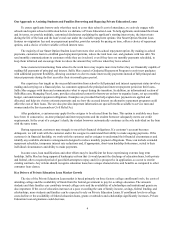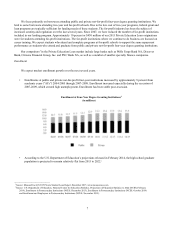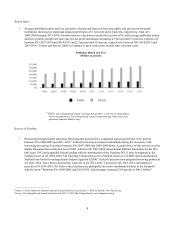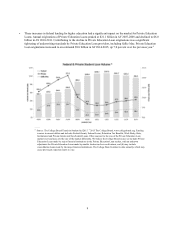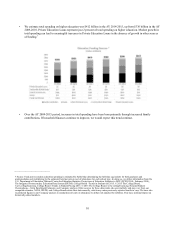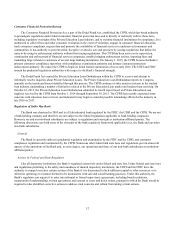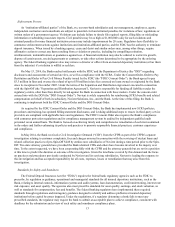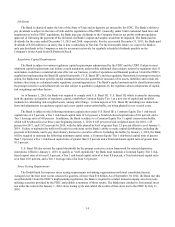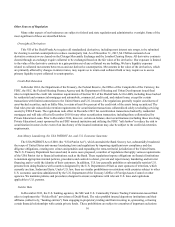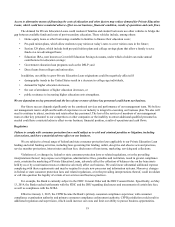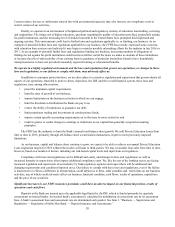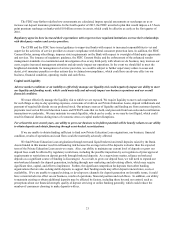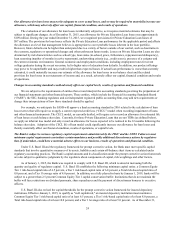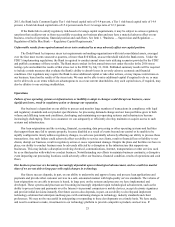Sallie Mae 2015 Annual Report Download - page 18
Download and view the complete annual report
Please find page 18 of the 2015 Sallie Mae annual report below. You can navigate through the pages in the report by either clicking on the pages listed below, or by using the keyword search tool below to find specific information within the annual report.16
Other Sources of Regulation
Many other aspects of our businesses are subject to federal and state regulation and administrative oversight. Some of the
most significant of these are described below.
Oversight of Derivatives
Title VII of the Dodd-Frank Act requires all standardized derivatives, including most interest rate swaps, to be submitted
for clearing to central counterparties to reduce counterparty risk. As of December 31, 2015, $4.9 billion notional of our
derivative contracts were cleared on the Chicago Mercantile Exchange and the London Clearing House. All derivative contracts
cleared through an exchange require collateral to be exchanged based on the fair value of the derivative. Our exposure is limited
to the value of the derivative contracts in a gain position net of any collateral we are holding. We have liquidity exposure
related to collateral movements between us and our derivative counterparties. Movements in the value of the derivatives, which
are primarily affected by changes in interest rates, may require us to return cash collateral held or may require us to access
primary liquidity to post collateral to counterparties.
Credit Risk Retention
In October 2014, the Department of the Treasury, the Federal Reserve, the Office of the Comptroller of the Currency, the
FDIC, the SEC, the Federal Housing Finance Agency and the Department of Housing and Urban Development issued final
rules to implement the credit risk retention requirements of Section 941 of the Dodd-Frank Act for ABS, including those backed
by residential and commercial mortgages and automobile, commercial, credit card, and student loans, except for certain
transactions with limited connections to the United States and U.S. investors. The regulations generally require securitizers of
asset-backed securities, such as Sallie Mae, to retain at least five percent of the credit risk of the assets being securitized. The
final rules provide reduced risk retention requirements for securitization transactions collateralized solely (excluding servicing
assets) by FFELP loans. The regulations took effect in December 2015 for securitization transactions backed by residential
mortgages and will take effect in December 2016 for any other securitization transaction, including those collateralized by
Private Education Loans. Prior to December 2016, however, certain on-balance sheet securitizations (including those involving
Private Education Loans) sponsored by an FDIC-insured institution and utilizing the FDIC "safe harbor" to reduce the risk to
securitization investors in the event of an insolvency of the insured institution may also be subject to the credit risk retention
requirements.
Anti-Money Laundering, the USA PATRIOT Act, and U.S. Economic Sanctions
The USA PATRIOT Act of 2001 (the “USA Patriot Act”), which amended the Bank Secrecy Act, substantially broadened
the scope of United States anti-money laundering laws and regulations by imposing significant new compliance and due
diligence obligations, creating new crimes and penalties and expanding the extra-territorial jurisdiction of the United States.
The U.S. Treasury Department has issued and, in some cases proposed, a number of regulations that apply various requirements
of the USA Patriot Act to financial institutions such as the Bank. These regulations impose obligations on financial institutions
to maintain appropriate internal policies, procedures and controls to detect, prevent and report money laundering and terrorist
financing and to verify the identity of their customers. In addition, U.S. law generally prohibits or substantially restricts U.S.
persons from doing business with countries designated by the U.S. Department of State as state sponsors of terrorism, which
currently are Iran, Sudan and Syria. Under U.S. law, there are similar prohibitions or restrictions with countries subject to other
U.S. economic sanctions administered by the U.S. Department of the Treasury’s Office of Foreign Assets Control or other
agencies. We maintain policies and procedures designed to ensure compliance with relevant U.S. laws and regulations
applicable to U.S. persons.
Volcker Rule
In December 2013, the U.S. banking agencies, the SEC and U.S. Commodity Futures Trading Commission issued final
rules to implement the “Volcker Rule” provisions of Dodd-Frank. The rules prohibit insured depository institutions and their
affiliates (collectively, “banking entities”) from engaging in proprietary trading and from investing in, sponsoring, or having
certain financial relationships with certain private funds. These prohibitions are subject to a number of important exclusions


